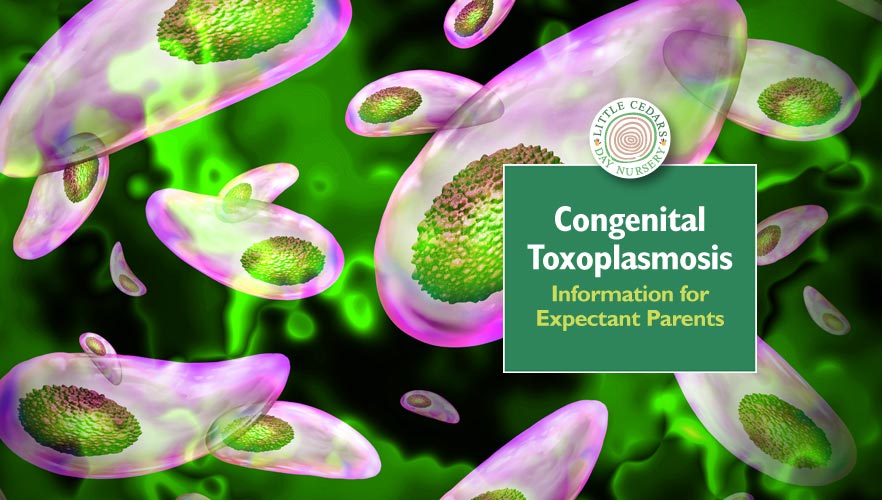
With a new baby on the horizon, pregnancy is often a time of excitement and anticipation. However, it is often also a time for heightened awareness around health and safety matters — and rightly so. Indeed it’s instinctive to want to protect both the expectant mother and the unborn child. While many expectant parents are familiar with common pregnancy risks, one lesser-known yet serious threat is congenital toxoplasmosis. This parasitic infection can have devastating consequences for unborn babies. In today’s post, we’ll explore what congenital toxoplasmosis is, the risks it poses, and practical steps pregnant women and families with young children can take to minimise exposure.
What is Congenital Toxoplasmosis?
Toxoplasmosis is an infection that’s caused by the parasite Toxoplasma gondii. While the infection is often harmless and asymptomatic for healthy adults, it becomes particularly concerning when a pregnant woman contracts it, as the parasite can cross the placenta and infect the developing baby. This is known as congenital toxoplasmosis.
How Common is Congenital Toxoplasmosis?
According to the pregnancy and baby charity Tommy’s, approximately 350 people are infected by toxoplasmosis each year in England and Wales. So, the chances of infection during pregnancy are small. However, this article is inspired by a real-life case where such an infection occurred during pregnancy. Sadly, the adverse effects for the child were severe and permanent.
What are the Risks to Unborn Babies & Young Children?
The timing of any exposure to the Toxoplasmosis gondii parasite during pregnancy affects both the risk of transmission and the potential severity of the effects on the foetus/child. While the transmission risk is lower during early pregnancy, the possible adverse effects for the developing foetus are much more severe. Conversely, the risk of transmission to the child is higher in late pregnancy but the potential effects may be milder or appear later in their lives. Depending on the timing, therefore, the risks to the child could be anything from mild effects that appear later in life to something as severe as brain abnormalities, eye damage, or even stillbirth. Other potential effects include seizures and neurological issues, miscarriages, hearing problems, learning disabilities and more. It is therefore incredibly important for expectant families to understand how to avoid toxoplasmosis infection.
“If you get toxoplasmosis while you’re pregnant it can cause miscarriage. If it spreads to your baby it can cause serious complications.” — NHS
How Pregnant Women Can Reduce The Risk
Preventing toxoplasmosis during pregnancy is crucial. Here are key measures expectant mothers should take:
Food Safety
- Avoid touching and/or eating raw or undercooked meat, especially lamb, pork and venison.
- Avoid touching and/or eating cured/dried/smoked meats like salami, Parma ham etc.
- Avoid handling and/or eating raw or undercooked oysters, clams and mussels.
- Ensure that fruit and vegetables are thoroughly washed.
- Avoid unpasteurised dairy products that may carry the parasite, especially those containing unpasteurised goat’s milk.
- Wash hands, kitchen surfaces, and utensils, especially after handling uncooked meat or indeed any of the above.
Pets & Animals
- If you are pregnant and own a cat, avoid changing the litter box yourself. If that’s not possible, ensure that you wear protective gloves while doing so and thoroughly wash your hands once you’ve finished.
- Consider keeping pet cats indoors during pregnancy to prevent them from hunting infected rodents or birds.
- Don’t give pet cats uncooked or undercooked meat.
- Avoid contact with sheep, especially pregnant sheep and lambs.
Hygiene and Environmental Care
- Always wash your hands after gardening or handling soil.
- Wear gloves while gardening or handling sandboxes (sandpits may be contaminated with cat faeces).
- Ensure meat is cooked to safe and sufficiently high temperatures.
Protecting Young Children from Infection
For families with toddlers and young children, it’s important to maintain hygiene practices to reduce exposure:
- Teach children to wash hands after playing outdoors, handling pets, and before eating.
- Cover outdoor sandpits to prevent contamination by neighbourhood cats.
- Ensure family meals follow proper food safety guidelines.
The Cat Myth
Many who have heard of toxoplasmosis believe its cause is linked primarily to cats. While cats are a host for Toxoplasma gondii and it can be contracted through contact with their faeces, they are not the most common way people get infected. Most often, contaminated food (such as undercooked meat, unwashed vegetables, or contaminated water) is the primary source of infection. Pregnant women should therefore be cautious about handling soil, raw meat, and unpasteurised dairy — not just cats. The NHS itself says:
“You cannot catch toxoplasmosis from stroking a cat, having a cat as a pet or from coming into contact with someone who’s got it.”
Stay Vigilant
Congenital toxoplasmosis is a serious but preventable condition. If they take the proper precautions, expectant mothers and families with young children can significantly reduce their risk of infection. Awareness and education are crucial, so feel free to bookmark and share this information with loved ones to help protect future generations. Learn more about toxoplasmosis and its symptoms here.
Little Cedars Nursery, Streatham, London SW16
A high-quality childcare service for your child at Little Cedars Nursery in Streatham


Little Cedars Nursery is a first-class nursery and preschool in Streatham in London’s SW16 postcode. The childcare setting offers high-quality weekday childcare for babies, toddlers, and children under five and opens virtually all year round. All major childcare funding options are supported and the nursery has ‘Good Provider’ status from Ofsted.
Find out more about Little Cedars Nursery in Streatham by choosing a button below. We’re here to show you around, answer questions, and welcome your child to this wonderful Streatham nursery.
Important Notice
These are introductory guidelines only — parents/guardians will need to do their own comprehensive research to learn more. They may also wish to consult our related tips on food safety and hygiene around children.


 Sooner or later, many parents will consider the possible benefits of pets and whether their child should grow up with one. Mostly, the answer is positive because growing up with a pet can benefit children in many important ways — and really enrich their lives. However, looking after animals is a huge responsibility, not least to the animal itself, so should never be taken on lightly. Today we explore the topic and also outline a couple of animal-related initiatives that we have undertaken at
Sooner or later, many parents will consider the possible benefits of pets and whether their child should grow up with one. Mostly, the answer is positive because growing up with a pet can benefit children in many important ways — and really enrich their lives. However, looking after animals is a huge responsibility, not least to the animal itself, so should never be taken on lightly. Today we explore the topic and also outline a couple of animal-related initiatives that we have undertaken at 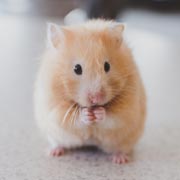 On a simple level, pets are incredibly cute and great fun to be around. As such, most children are naturally drawn to them.
On a simple level, pets are incredibly cute and great fun to be around. As such, most children are naturally drawn to them. Familiarity with animals and closeness to pets also teaches children respect for other individuals (whether human or non-human), including recognition of the consequences of their actions towards them. It shows them how to care for others too. It can also teach them patience (e.g. when training) and even some of the harder lessons about life cycles.
Familiarity with animals and closeness to pets also teaches children respect for other individuals (whether human or non-human), including recognition of the consequences of their actions towards them. It shows them how to care for others too. It can also teach them patience (e.g. when training) and even some of the harder lessons about life cycles. Introducing animals like dogs and cats to the household is quite a life-changing thing. After all, they are the kinds of animals that pretty much become one of the family and, as such, require significant time, care and attention for their own wellbeing. They also often live freely within the house and require access to the garden and, for dogs, regular walks outdoors. They are quite an undertaking, so the decision to introduce one needs careful and thorough consideration. Many animals form deep, lifelong bonds and you will become their family just as much as they become yours. So, that lifelong commitment is an important one — they are absolutely not unfeeling objects to be treated like just a toy.
Introducing animals like dogs and cats to the household is quite a life-changing thing. After all, they are the kinds of animals that pretty much become one of the family and, as such, require significant time, care and attention for their own wellbeing. They also often live freely within the house and require access to the garden and, for dogs, regular walks outdoors. They are quite an undertaking, so the decision to introduce one needs careful and thorough consideration. Many animals form deep, lifelong bonds and you will become their family just as much as they become yours. So, that lifelong commitment is an important one — they are absolutely not unfeeling objects to be treated like just a toy.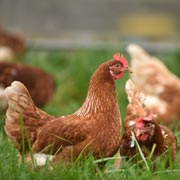 Pets like hamsters, rabbits, budgies and guinea pigs require less space in the household, of course. Indeed, some types of pets can be housed outdoors in suitable hutches. They’re also small enough to be temporarily moved elsewhere, for example to a friend or neighbour when you go on holiday. However, despite them being small, they too have their own needs and wants, including your care and regular attention. Giving them this, however, will be rewarded and children who spend significant time with any pet will soon begin to pick up on each one’s distinct personality and any likes or dislikes. Treat them well and pets will become trusting and friendly. Dogs, in particular, are incredibly loyal when treated well.
Pets like hamsters, rabbits, budgies and guinea pigs require less space in the household, of course. Indeed, some types of pets can be housed outdoors in suitable hutches. They’re also small enough to be temporarily moved elsewhere, for example to a friend or neighbour when you go on holiday. However, despite them being small, they too have their own needs and wants, including your care and regular attention. Giving them this, however, will be rewarded and children who spend significant time with any pet will soon begin to pick up on each one’s distinct personality and any likes or dislikes. Treat them well and pets will become trusting and friendly. Dogs, in particular, are incredibly loyal when treated well.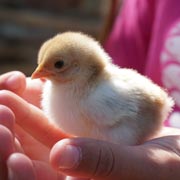 Just like humans, animals need care, proper food, fresh water, friendship, comfort and stimulation. If they don’t get these essentials, they may lead miserable and potentially even foreshortened lives. So, before a family takes on a pet, it’s best to thoroughly research the particular type of animal and exactly what they will require, from food, nutrition and bedding to stimulation (games, exercise etc.), contact with others and medical needs. Families should find out about all these things before taking an animal on. For some types of animal, for example dogs, even the breed and background is important. That’s for the wellbeing of both the pet and the family itself. Remember too that some animals will need training, for example toilet training in the case of cats, dogs and perhaps even ‘house’ rabbits. Some dogs may also require behaviour training. Everything needs factoring in beforehand including things like who will look after the pets while adults are at work, what happens when you go on holiday, who will exercise the dog, clean out the rabbit hutch regularly, feed the rabbit or clean the budgie cage.
Just like humans, animals need care, proper food, fresh water, friendship, comfort and stimulation. If they don’t get these essentials, they may lead miserable and potentially even foreshortened lives. So, before a family takes on a pet, it’s best to thoroughly research the particular type of animal and exactly what they will require, from food, nutrition and bedding to stimulation (games, exercise etc.), contact with others and medical needs. Families should find out about all these things before taking an animal on. For some types of animal, for example dogs, even the breed and background is important. That’s for the wellbeing of both the pet and the family itself. Remember too that some animals will need training, for example toilet training in the case of cats, dogs and perhaps even ‘house’ rabbits. Some dogs may also require behaviour training. Everything needs factoring in beforehand including things like who will look after the pets while adults are at work, what happens when you go on holiday, who will exercise the dog, clean out the rabbit hutch regularly, feed the rabbit or clean the budgie cage.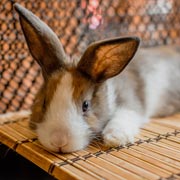 At Little Cedars Nursery in Streatham, we believe that children will learn a huge amount through contact with animals. For this reason, we have our own chickens and rabbits at the setting — and the children adore them! Our rabbits are named Miffy and Bella and indeed naming them naturally encourages children to treat them like individuals rather than something to play with.
At Little Cedars Nursery in Streatham, we believe that children will learn a huge amount through contact with animals. For this reason, we have our own chickens and rabbits at the setting — and the children adore them! Our rabbits are named Miffy and Bella and indeed naming them naturally encourages children to treat them like individuals rather than something to play with.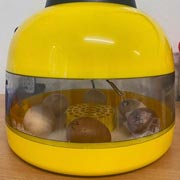 We are also raising some new chickens from fertilised eggs that we currently have in an incubator. We’ll teach children all about the life cycle of chickens with these. Once they hatch, children are sure to love the adorable little chicks that will emerge and they’ll be able to watch them grow up from fluffy chicks to adult chickens. When old enough, the chickens will join our existing, fully-grown chickens that we keep for the children in our animal enclosure outside.
We are also raising some new chickens from fertilised eggs that we currently have in an incubator. We’ll teach children all about the life cycle of chickens with these. Once they hatch, children are sure to love the adorable little chicks that will emerge and they’ll be able to watch them grow up from fluffy chicks to adult chickens. When old enough, the chickens will join our existing, fully-grown chickens that we keep for the children in our animal enclosure outside.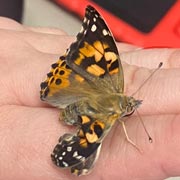 We also have a caterpillar/butterfly enclosure indoors at the setting. Through this, children can follow the incredible life cycle of butterflies, starting off as tiny eggs, hatching into caterpillars, building cocoons and eventually emerging as incredibly beautiful butterflies. This is an amazing metamorphosis for children to witness and teaches them so much about the wonder of the natural world as well as the individual needs of some of its creatures.
We also have a caterpillar/butterfly enclosure indoors at the setting. Through this, children can follow the incredible life cycle of butterflies, starting off as tiny eggs, hatching into caterpillars, building cocoons and eventually emerging as incredibly beautiful butterflies. This is an amazing metamorphosis for children to witness and teaches them so much about the wonder of the natural world as well as the individual needs of some of its creatures.